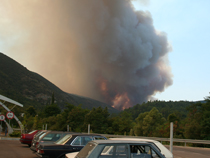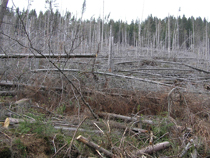Others
ABIOTIC HARMFUL AGENTS represent the most significant factors of forest destabilization. In most cases, they cause decline and often even the extinction of forest stands. They are also known as primary harmful agents. Recently, their impact has become more intense. It is connected to climate change, which brings extreme weather events, windstorms, snow disasters, and long-lasting droughts. Even the largest trees cannot withstand strong winds and heavy snowfalls. Human possibilities to reduce these catastrophic consequences are limited. Therefore, scientists try to study the laws of extreme events and look for ways to predict their occurrence.
Wind causes tremendous damage to forest stands every year. It is usually a falling type of wind and a nozzle effect of an accelerated air stream. The wind speed is affected not only by the motion of air masses with significantly different air pressure but also by the orography of the terrain. As a result, trees are uprooted or broken in different parts of the trunk. In winter, conifers up to 50 years are especially threatened by heavy wet snow. Damaged trees have broken tops of 2-3 m in length; the calamity is usually scattered, making it challenging to find damaged trees and process them. Particularly endangered with early frosts (in autumn) are trees whose youngest shoot tissues are not matured, and a temperature several degrees below zero can irreversibly damage cells of those tissues.
Late frosts occur in the spring when the trees sprout. The flower and leaf buds are damaged, the bark tissues usually remain undamaged, and the trees can sprout again. The trees in the valleys are primarily at risk. Icing is caused by freezing water vapor on the branches of trees; by several centimeters of ice layers, the branches are overloaded and bend and then break. A cycle of warm and sunny days with precipitation is necessary for spring and summer. The trees suffer from drought due to a deficit of rainfall. Delicate roots dry out, and symptoms manifest on the crown by wilting of assimilation organs, browning, and premature fallout. Some groups of insects and fungi can survive the drought without significant issues and become severe pests of physiologically weakened trees under these conditions. When the vegetation cover is removed, tree trunks are exposed to direct sunlight. Such exposure to sunlight weakens the trees and makes them more susceptible to other harmful biotic agents. High temperatures irreversibly damage the tree bark. The bark subsequently falls off, and it loses its protective function. Tree injuries from the sun on the bark are known as sunscald and sunburn. During floods, there is excess ground or surface water in the soil. As a result, there is a deficit of oxygen, and the roots die. The damage manifests in the assimilation organs' withering, browning, and premature defoliation. Often, the roots are irreversibly damaged, and the trees can't regenerate anymore.
ANTHROPOGENIC HARMFUL AGENTS. Human impact on forests is often very destructive. Sometimes it acts globally (greenhouse gases, emissions...), other times locally (fires, tourism, etc.). Human impact on forests has recently been under public scrutiny thanks to ecological initiatives. As a result, the effects of immissions, grazing, etc., have decreased. Despite the efforts to change the approach, some global problems still cannot be solved. It is related to the growth of human society. However, one must realize the importance of the forest and try to preserve it for future generations at all costs. Emissions have long been among the most significant anthropogenic harmful factors. The damage to the vegetation is mainly evident in the vicinity of the industrial centers. Recently, the importance of fires has been increasing. Wood theft, tourism, and grazing are less important anthropogenic harmful factors.
OTHER BIOTIC AGENTS. Rodents can severely limit forestry activities along water streams, reservoirs, and canals. Protection is often complicated. Nematodes threaten the seed's health of seedlings, but in some European countries, they cause severe damage to mature trees. Undesirable vegetation is a problem in forest nurseries and plantings. High financial costs are spent on chemical treatments or manual pruning. Wild animals also belong to severe pests. These can decimate immature stands by browsing bark, terminals, side shoots, and damage already secured stands.
 |
 |
 |
 |
|
Invasive plants. Foto: M. Zúbrik |
Illegal logging. Foto: M. Zúbrik | Fires. Foto: M. Zúbrik | Wind disasters in forests. Foto: M. Zúbrik |



